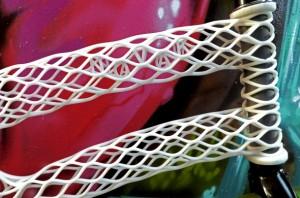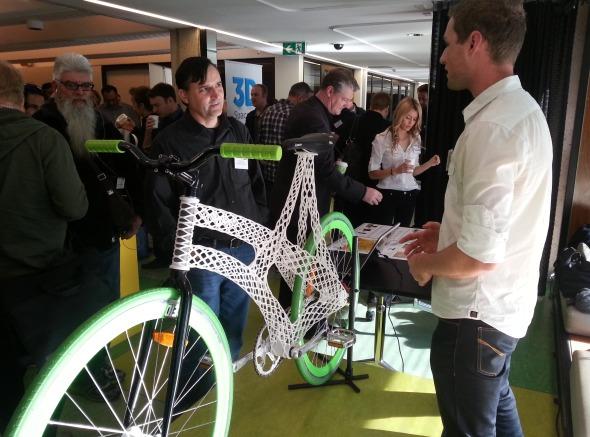Using 3D printing technology to create a bicycle is no longer particularly new. That doesn’t mean, however, that anytime it happens it’s old news. James Novak took a crack at the bicycle and came up with this very unique frame that allowed him to fully explore and exploit the potential of 3D printing in customized sports equipment.
James Novak is one of those people who can’t stop finding things interesting. Despite already having an undergraduate degree in architecture and a master’s in product design, he still confesses that he doesn’t know what he wants to be when he grows up…if he even decides that growing up is something he wants to do at all. Even while working on a number of high profile projects as a professional industrial designer, he felt the urge to push the envelope.
 Novak confessed, “I was always searching for something more, something that I could really sink my teeth into and get excited about it.” With his bicycle project, he found just what the doctor ordered. It started when he visited Griffith University, his alma mater, and came upon their 3D printing equipment. Not to give up his status as a life-long learner, he decided that in addition to teaching there as a lecturer, he would also enroll in a PhD program focusing on additive manufacturing for sporting products. It gives him the opportunity to, “play with all these toys,” as he put it.
Novak confessed, “I was always searching for something more, something that I could really sink my teeth into and get excited about it.” With his bicycle project, he found just what the doctor ordered. It started when he visited Griffith University, his alma mater, and came upon their 3D printing equipment. Not to give up his status as a life-long learner, he decided that in addition to teaching there as a lecturer, he would also enroll in a PhD program focusing on additive manufacturing for sporting products. It gives him the opportunity to, “play with all these toys,” as he put it.
While playing, he began work on the frame of a bicycle in an effort to determine how far he could exploit the unique nature of 3D printing.
“What I really wanted to achieve was something that takes full advantage of the benefits of 3D printers, especially the ability to create one-off, customizable pieces that may be lighter-weight and stronger than traditional frames through the use of complex lattice structures. More than anything, I’d like my work to be an example of what we should be 3D printing.”
 The bike was designed to exactly fit the proportions of its designer body and is a fascinating first foray into the world of customizable sporting goods and 3D printing. To create the product was not, if you will pardon the expression, as easy as falling off a bike. Novak spent approximately 150 hours modeling the item, using 3D SolidWorks and then had to figure out how much of what he was trying to do could actually feasibly be accomplished with 3D printing. All in all, the process took four months of continual refinement and redesign before he was able to create something usable.
The bike was designed to exactly fit the proportions of its designer body and is a fascinating first foray into the world of customizable sporting goods and 3D printing. To create the product was not, if you will pardon the expression, as easy as falling off a bike. Novak spent approximately 150 hours modeling the item, using 3D SolidWorks and then had to figure out how much of what he was trying to do could actually feasibly be accomplished with 3D printing. All in all, the process took four months of continual refinement and redesign before he was able to create something usable.
The final bike was printed in paintable resin through i.materialise and then exhibited in Brisbane, Australia. Novak hopes that this won’t be the end of a journey, but rather a beginning.
“A lot of great ideas for the future have come from my experimentation so far, and I’m planning to launch a website selling some of these once I get through my studies. The side will be called edditive.com and will hopefully feature the final resolved fixie frame for sale in the future.”
What do you think about this unique bicycle design, and the method of production? Discuss in the 3D Printed bicycle forum thread on 3DPB.com
Subscribe to Our Email Newsletter
Stay up-to-date on all the latest news from the 3D printing industry and receive information and offers from third party vendors.
Print Services
Upload your 3D Models and get them printed quickly and efficiently.
You May Also Like
U.S. Navy Lab Uses 3D Printing to Reduce Tooling Lead Time By Over 90%
The F-35 Lightning II Joint Program Office (JPO), responsible for life-cycle management of the key fifth-generation joint strike fighter (JSF) system used by the U.S., its allies, and its partners,...
Etsy Design Rule Change Reduces Selection of 3D Printed Goods
Online marketplace Etsy has implemented a rule change requiring all 3D printed goods on the site to be original designs. The update to the site’s Creativity Standards states, ¨Items produced using...
Honeywell Qualifies 6K Additive’s Nickel 718 for 3D Printed Aerospace & Defense Parts
6K Additive is renowned for manufacturing sustainable additive manufacturing (AM) powder, and offers a wide portfolio of premium metal and alloy powders that include titanium, copper, stainless steel, and nickel,...
MetalWorm Sells WAAM Systems to Research Institutes in Brazil and Malaysia
Turkish WAAM firm MetalWorm has sold a system in Malaysia and another in Brazil. This is an excellent example of a few emerging trends in additive. Firstly, WAAM was experimented...

































